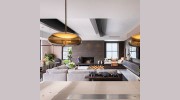Frank Close has dedicated his life to the art of architectural stained glass. His studio, nestled in Lexington, Kentucky, is where his passion for translating light, form, and vision into breathtaking works of art takes shape. Frank's journey began in the vibrant 1970s, amidst the artistic energy of Berkeley, California. There, he absorbed the teachings of renowned glass artists Casey Lewis, Peter Mollica, and the influential German artist Ludwig Schaffrath, honing his skills and developing his unique aesthetic.
His artistic odyssey led him through various cities, each leaving its mark on his craft. He established his first studio in Keene, Kentucky, before relocating to the nearby vibrant city of Lexington. The energy and creativity of New York City beckoned him in 1987, where he opened a studio in the heart of Greenwich Village. Later, he formed a fruitful partnership with glass artist Patricia Patenaude, establishing "Patenaude / Close" in the trendy SoHo district. Over the years, Frank's studios have moved as his creative vision unfolded, eventually returning to his roots in Lexington where he continues to create.
A Collaborative Approach
Frank Close's artistry shines in its responsiveness to its surroundings. He believes in collaboration, working closely with architects, designers, and clients to ensure that each piece of stained glass becomes a harmonious extension of its environment.
His designs embrace light as a crucial element, understanding its subtle interplay with glass and its surroundings. Utilizing line as a fundamental design principle, he orchestrates a captivating dance of light and color, transforming each space into a unique and captivating theater of refracted beauty.
Creating Enduring Works of Art
From the grand spaces of international organizations to the intimate sanctuaries of religious settings, Frank Close's work transforms ordinary structures into extraordinary destinations. The International Monetary Fund in Washington, D.C., the Gateway Center in Newark, New Jersey, and the Church Street Station, as well as the United States Post Office and Federal Office Building in New York City, bear testament to his ability to elevate architectural spaces through stained glass.
His expertise resonates across a wide range of projects, leaving his mark on educational institutions like Central Lakes College in Brainerd, Minnesota, and Pace University in New York City. He brings a sense of timelessness to corporate environments at Prudential Mitsui Office Center in Short Hills, New Jersey, and Doral Country Club in Miami, Florida, while adding a touch of grandeur to iconic landmarks like the Lexington Cemetery Mausoleum.
Each piece Frank Close creates is more than just glass and lead; it is a testament to the power of human creativity to transform ordinary spaces into extraordinary experiences.
The Rondel Series and Architectural Legacy
Frank Close's artistic journey extends beyond monumental structures. His fascination with the art of blown glass roundels, known as rondels, blossomed through a collaboration with renowned architect Randy Correll. Inspired by the traditional Venetian glass roundel windows, Correll envisioned a residential leaded glass window comprised of these exquisite roundels. Frank accepted the challenge, embarking on a series of projects that explored the unique qualities of this ancient art form.
The Rondel Series became a testament to Frank's mastery of both traditional and contemporary techniques. These captivating roundels, often inspired by nature and imbued with vibrant colors, found their way into homes and public spaces, adding a touch of classical elegance and artistic sophistication. The Genesis Masterman Door Studio Roundel, the Martha's Vineyard French Door Design, and the stunning Saul Good Sutton Place Brooklyn Townhouse Penthouse Roundel stand as shining examples of the beauty and versatility that defines the Rondel Series.
These projects showcase Frank Close's profound understanding of glass as a medium for expressing both strength and fragility, form and function.

Be the first to review Frank Close Studio.
Write a Review




